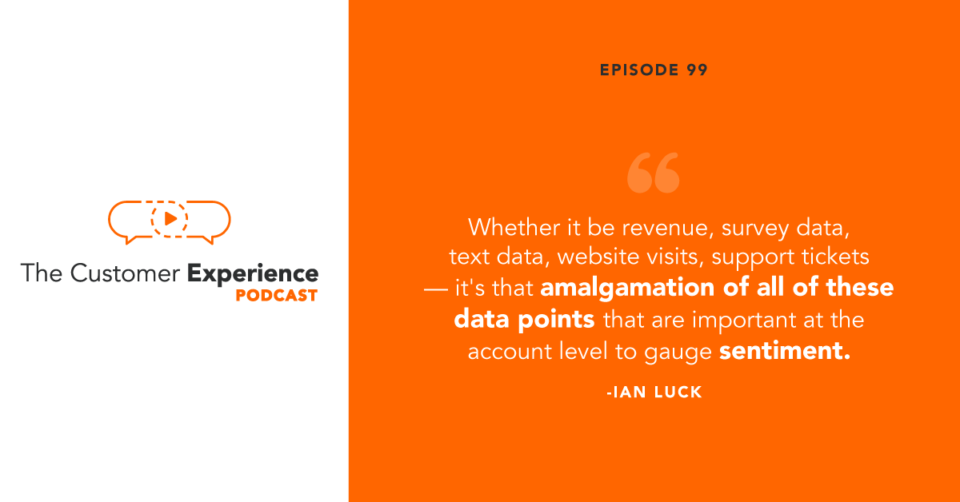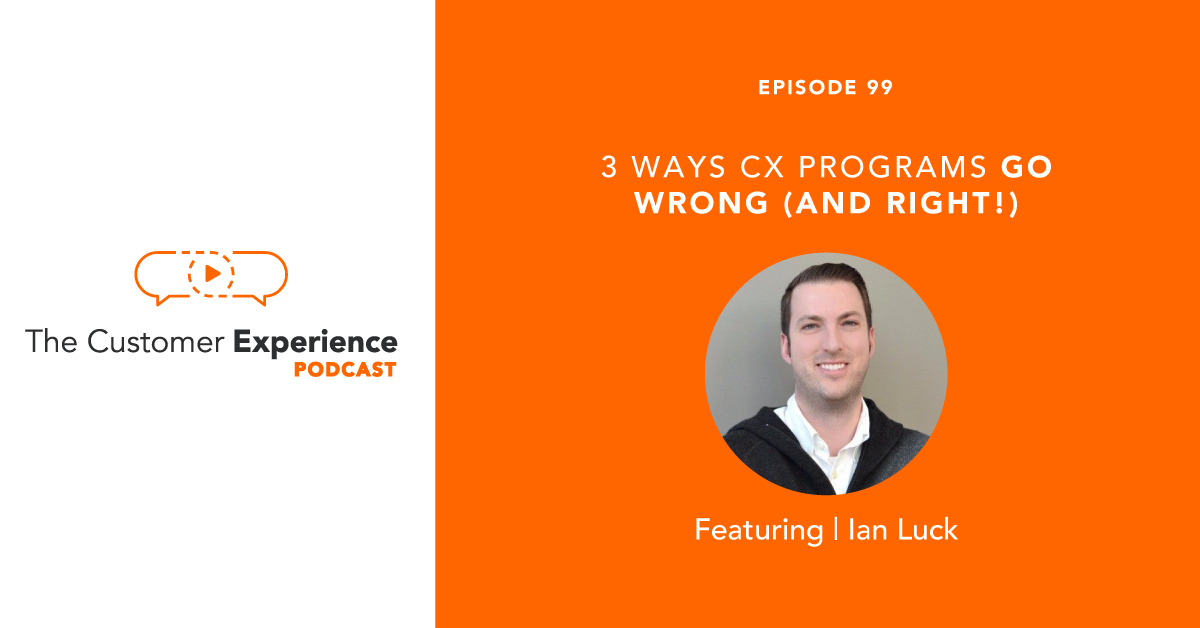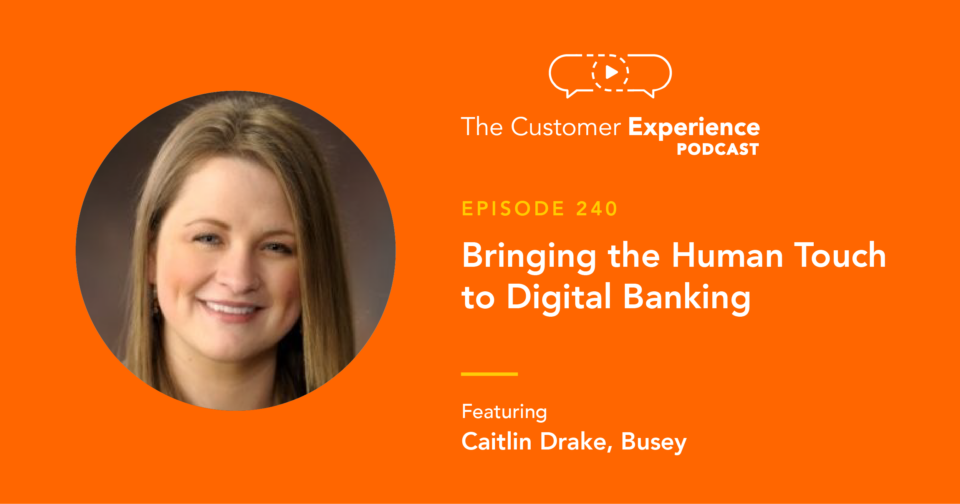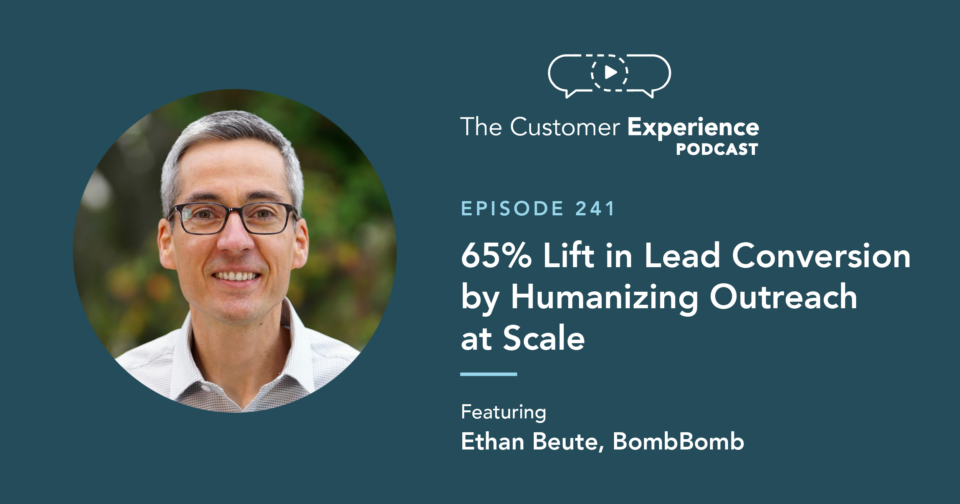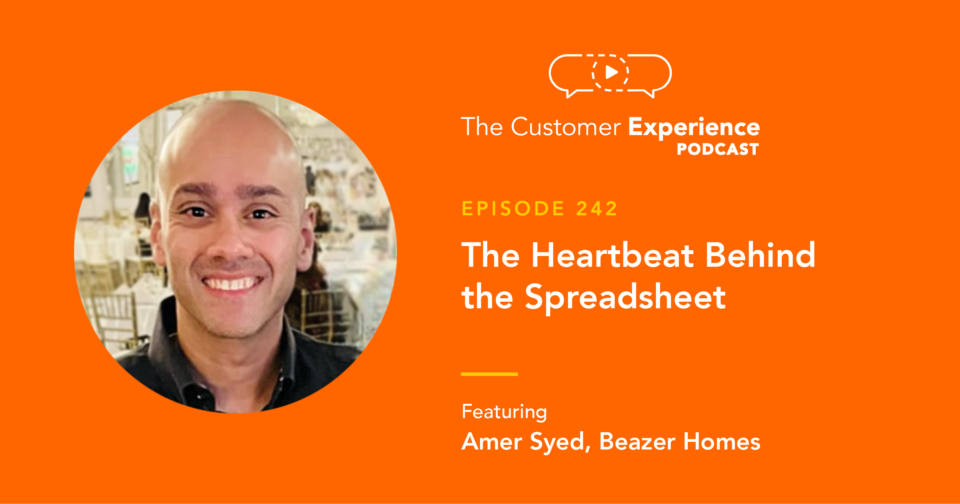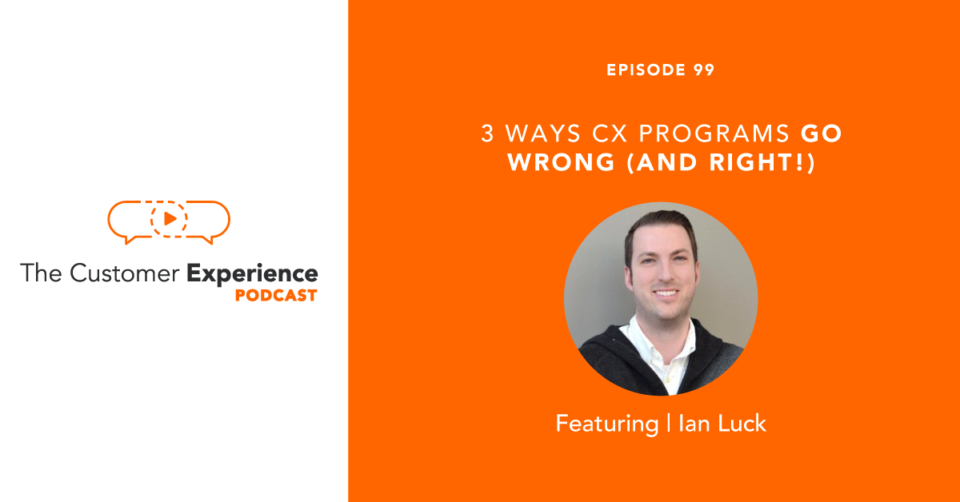
Listen to “99. 3 Ways CX Programs Go Wrong (and Right!) w/ Ian Luck” on Spreaker.
Apple Podcasts | Google Podcasts | Stitcher | Spotify
Is your customer experience program aligned with the interests and expectations of your C-Suite? If not, then you have a CX gap. And this could be getting in the way of the success of your CX program.
This misalignment could be the source of all of your frustration because there’s a fundamental difference in goals. While CX practitioners are focused on creating a customer-centric culture and positive account sentiment, executives and revenue operators are focused on hard numbers – typically those with dollar signs immediately attached.
So how do you overcome this?
Our guest on this episode of The Customer Experience Podcast, Ian Luck, is an expert in bridging this CX gap.
Founder of Marketing Strategy, Ian serves the VP of Global Marketing at CustomerGauge, a B2B account experience software. He brings to this episode vast experience creating internal alignment to correcting the most common CX mistakes.
He also brings his experience as a retention marketing manager and demand gen agency founder to weigh in on making customer-centric decisions based on accurate CX data.
In our conversation, we talk about…
• What defines the customer experience
• Why measuring account sentiment is a necessary evolution in your business
• Why failing to focus on action and siloing your data are CX misses
• What a successful CX program looks like (with examples!)
• Why Net Promoter Score (NPS) remains essential to company growth … if you use it the right way
3 Ways CX Programs Go Wrong (and Right!)
Hear the entire conversation with Ian Luck of CustomerGauge right here:
Listen to “99. 3 Ways CX Programs Go Wrong (and Right!) w/ Ian Luck” on Spreaker.
Hear this episode of The Customer Experience Podcast – and many others – by subscribing to in:
Check out the podcast in your preferred player by clicking a link above. Then click again once you’re there to leave a rating! That extra click (on 5 stars!?) is extremely helpful to the show.
Sign up for a monthly email with CX insights and highlights
By entering your email, you are agreeing to receive occasional BombBomb news & communication. We will never sell or distribute your email address to any 3rd party. You can manage your communication preferences here.
View our Privacy Policy.
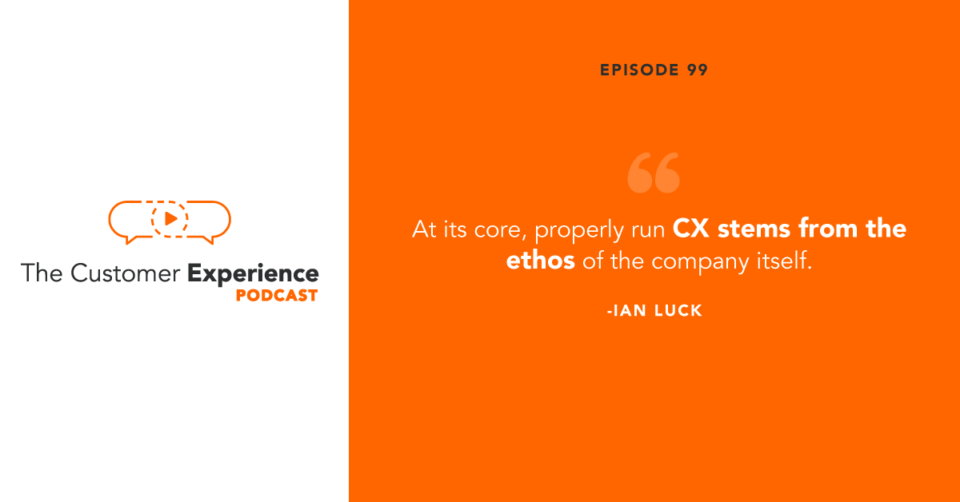
Full Transcript: 3 Ways CX Programs Go Wrong (and Right!)
Ethan Beute:
The CX gap. It’s the gap that leaves some customer experience initiatives and programs under-resourced at best and DOA at worst. Today we’ll talk about what causes that gap and ways to bridge it so that your team can start or continue identifying CX issues. Advancing a more customer-centric culture, and developing CX insights with the support you need. Among other activities and accomplishments. Our guest today is served as a retention marketing manager. He’s created an online community for rapid growth marketers, and he founded his own Demand Gen agency.
Ethan Beute:
He also serves as VP of global marketing for CustomerGauge, which combines experience and revenue data with account insights for clients like H&R Block, Eventbrite, and DHL. So they can make more customer-centric decisions and grow revenue faster. Ian Luck, welcome to the Customer Experience Podcast.
Ian Luck:
Hi, thank you so much for that great intro Ethan. It’s phenomenal, thank you.
Ethan Beute:
Yeah, I like the variety of things that you’re involved in. Talk a little bit about that. At what point did you decide before we get into customer experience. At what point did you decide, you know what, this rapid growth marketing thing we need to pull the people together and create a culture and community around it?
Ian Luck:
Yeah, so I’m a big proponent of LinkedIn right now. And if you go on LinkedIn, there are a ton of sales experts on LinkedIn. And I’m talking like, a massive amount of people that are just kicking out some amazing insights every single day on LinkedIn for sales. But I mean, and there’s a good amount of marketers too, lately. Especially now with…those types of people. Sweet Fish Media stepping up their game on LinkedIn. But there’s not a true community, for example, Sales Hacker is a great one for sales. But I haven’t really found that go to community for marketers, where they can share their deep insights at the tactical and strategic level.
Ian Luck:
So that’s kind of what really drove me to create that marketingstrategy.com community. And that’s kind of been the history of it. It’s started from just a place of selfishness, I think. I wanted a place for myself to learn from other marketers, and we just rolled it out from there.
Ethan Beute:
That’s awesome. And there’s something really strong about that sense of community. I’ll never forget in a previous industry that I worked in. I felt like I was alone in my local market. And then you go to New York for the big international conference, you’re like, “Oh, my gosh, all these people are facing the same things I’m facing. They have the same problems they’re facing.” Yeah, t’s really nice to feel like you’re not alone, especially today. So it’s awesome. So let’s start where we always start here, which is customer experience. When I say customer experience to you, Ian, what does that mean to you?
Ian Luck:
Oh, my God. So it’s such a great question. It means a ton of things. But if I had to narrow it down. I think it’s the sentiment of your brand, your people, your process, your technology, from the perspective of your customers. And it encompasses every single touchpoint you have across the entire journey. But really, above all else, I think it’s one of the only lasting differentiators that brands can leverage for a long-term profitable growth when it really comes down to it.
Ethan Beute:
Great answer. I love it. It ties together so many things that I also know are true of customer experience. First, you said it from the customer’s perspective, and the customer’s reality is the reality we can argue about it if we want to. But that is the reality. And the key point of differentiation is the thing as well. I mean, beyond product, beyond features, beyond price that is the differentiator that is difficult to knock off and it starts inside out.
Ian Luck:
You got it. And that’s exactly what we’re saying is that price promotion product placement are kind of the old marketing mix. But I think it’s being replaced by honest experiences now.
Ethan Beute:
It’s awesome. I guess I’ll just extend that a little bit. Where, do you think the intersection… There’s a school of thought that says customer experience is an outgrowth of the customer success organization. And that’s where it lives. And that’s where it comes from. And that’s its birthplace. But then there’s also the look that is across the lifecycle kind of a CRO type approach to CX. Which is, it is all of the customer touchpoints. And it might come out of marketing. For you, where does CX come from? And what is this intersection with marketing? There’s obviously a deep relationship there. But what is that relationship to you?
Ian Luck:
Yeah, great question. I think at its core, properly run CX stems from the ethos of the company itself. So whether it be from the founder, that puts it in place, or the CEO that makes it a prioritized initiative at the company level. I think it really does stem from who you guys are as a company. But then it really does spread across the entire org, every department should touch it in some way, shape, or form. So I’m not knocking customer success, I think there’s definitely a purpose for it.
Ian Luck:
But I think what really sets some of the companies that do this experience thing apart, are the ones that integrated across all departments, effectively, tie it to ROI, tie it to revenue, and report at that level, to the CEO. I think that’s really the difference that we talk about often. But it really, for me it’s across all touchpoints, all departments, there really has to be for it to be a meaningful thing.
Ethan Beute:
Awesome, you really did a nice job of previewing where we’re going to go here over the next several minutes. But before we get there, I would love to start with CustomerGauge. For folks who aren’t familiar. Tell us a little bit about CustomerGauge, specifically who is your ideal customer? And what are some of the problems that you solve for them?
Ian Luck:
Yeah, so customer needs is a B2B account experience software. So we focus primarily on B2B companies. And what we do really well is we handle the complexities that go along with those B2B companies. So a lot of these customer experience software’s they focus on single contact type feedback, what we do is we look at it from an account level. So if you’re a sales and marketing organization that have account-based marketing processes in place. We bolt on right to the customer side of that. We really focus on providing a view of sentiment at the account level. And not only that, we provide you with the tools to be proactive, to followup with that feedback in real-time, across multiple different departments. We have dashboards for sales, marketing, customer success, whatever it may be. But we really help you predict where churn will happen and get ahead of it before it does happen. It’s really what we do well.
Ethan Beute:
Really interesting. So I can imagine a number of data sources, obviously plugging into and feeding it. What are some common inputs to the material that you’re reorganizing into a very sensible fashion for people?
Ian Luck:
Yeah, so the first one we start with is honestly revenue, we literally lead with revenue. So we want you to… If you have old survey data, we can upload that as well. But if you want to start from the ground up, we basically say, “Alright, give us a list of accounts with the revenue.” And then we start their actual experience program, we send out surveys, we do in-app surveying, whatever it may be. How we collect the data, we take all these inputs, right. Whether it be revenue, survey data, text data, website visits, support tickets, it’s kind of like that amalgamation of all of these data points that are important at the account level to gauge sentiment. And sometimes honestly absence of signal is really what is driving this account experience software on the back end.
Ian Luck:
It’s saying alright, this account we haven’t really heard from them in a little bit. Their last score was maybe a seven or six, they haven’t visited the website in a while, they haven’t consumed content. That’s kind of what we have baking in the back end, that smart algorithm that really starts to predict, all right maybe you might want to reach out to these guys now, six months before the renewal date. To make sure that they don’t churn, they have everything they need to continue your relationship with X company. That’s basically-
Ethan Beute:
I love it. I love that your example, there was that big, quiet middle. Where they’re not frustrated or confused enough to reach out to support. They may be filling out the NPS surveys and it’s good, not great. They’re not obviously actively using the software. And that is the big kind of silent threat in any customer database, really. It’s easy… Easy, not fair to say. But it’s a great opportunity. Anytime you have someone on the line to improve sentiment, whether they’re there because they’re confused, frustrated, or maybe even downright angry. But there are some little things you can do to turn that around. And of course, your biggest friends, fans, advocates are already engaging with you and they’re out there, hopefully bringing new customers and that type of thing.
Ethan Beute:
But the opportunity to engage people who are just off the radar is so valuable, I love it. One follow up there and the word sentiment, right. You’re talking about account sentiment, and it’s not account activity. It’s not account usage. It’s not account expansion, although that’s kind of rolled into it. To me, sentiment has kind of a connotation that is… I really like it, it’s a little warmer, it’s a little more feeling-oriented, at least in some of its connotations. Talk about the choice of the word sentiment there.
Ian Luck:
Yeah, so what I mean by that is exactly what you said Ethan. A lot of companies approach it from like, “Hey, let’s get all of this random data and usage stats and things like that.” And I think that stems from customer success a little bit. And that’s okay, right. There’s nothing wrong with that. But what we found to be very valuable is actually getting sentiment across three levels of the organization, C-level, middle management, and the frontline staff, right.
Ian Luck:
So and this is essential, how does the C-level feel about your solution? How does the middle management feel about your solution? How does the frontline feel about your solution? And that is what we really mean by sentiment, right. You get a very clear view. And this happens all the time, your C-level loves it they see the value in the solution. Middle management’s maybe split, but then the front line hates you. The people are using the product every single day, they are not happy with your solution at all. They do not want to go into it every day. And that’s like, common for a lot of companies.
Ian Luck:
And we work with a good amount of companies that have that split, where the C-level gets it, they see the value. But maybe you could do some improvements to make the frontline staff their experience a little bit better. So when I say account sentiment, it’s really looking at it from a holistic standpoint. It’s not just one contact and randomly this guy’s VP of Marketing, right. It’s really segmenting your audience at the account level, and then getting sentiment on each individual section of those audiences. But then layering in those other data sources, like visits, like usage, like support tickets, and that’s when you really start to get… And we really lead. We believe in NPS, that is our one of our main things. We really do get behind and…if done properly.
Ian Luck:
Because, that really is the best indicator sentiment, but it’s also the best indicator of again, long term profitable growth. Now we also believe NPS isn’t necessarily enough anymore, you have to do some of those other things. But that’s really what we mean is you get the sentiment at the account level. And kind of layer in those extra little spices to hopefully help you predict churn a little bit quicker.
Ethan Beute:
Really good, we will probably get to monetized NPS as a concept, and as a practice, or as an evolution. But let’s start here now with the CX gap. Let’s go into an organization that whether they’re implementing something like CustomerGauge, or whatever else a CX initiative looks like, talk about… Well, first, I guess let’s start within my mind, there are a range depending on if you are an H&R Block or an Eventbrite I’m sure a CX initiative looks a lot different than if you are a probably even a CustomerGauge or a BombBomb.
Ethan Beute:
And so maybe start by defining customer experience initiative, or project or whatever. And talk about kind of the range of scope there. And maybe some of the pitfalls to avoid when you start with a new one.
Ian Luck:
It’s really astute observation. So let me expand on that. We talked to a good amount of prospects, as you can imagine. And we talked to a good amount of customers. But I think on the prospect side, the really interesting thing, especially from a marketing standpoint. And it’s actually a challenge, which I love my team loves, but no program is the same. So every company we talk to nobody’s doing it the same way. And I think that’s what’s really interesting about the experience marketplace. Is that there’s so many variations of what people think to be best practice and how they’re actually implementing their system. And it’s not even the same across industries, or in industry, even, for example, SaaS companies do it a bunch of different ways. IT services do it a bunch of different ways.
Ian Luck:
So that really is a good caveat Ethan is basically it can vary. An H&R Block will do it very differently than DHL or Anheuser Busch. For example, Anheuser Busch is using our account experience software to measure their distribution channel, whereas H&R Block is using an almost a B2B, B2C context where they’re measuring the franchisee at the B2B level, their sentiment with the franchise. But they’re also measuring it at the B2C level for their end-user customers. So it really does run the gamut of things. And it is interesting, and they’re all structured differently. Departments own it in different orgs. For example, marketing sometimes owns or there is a CS, customer success team that owns it, or there’s a customer experience team that owns it. I’ve seen finance own it, I’ve seen operations own it.
Ian Luck:
It’s tough from a marketing standpoint because I can’t just say, “Alright, this is our persona, we’re going after operations, boom, done.” And I don’t want to say easy, because again to your point, nothing’s easy anymore. But it’s an easier marketing tactic is to line up a persona. But yeah, it really is different for every org. But at the core of it, the companies that we work with that do extremely well. Are the ones that understand it’s about action. It’s not just measuring it, it’s not just saying, “Hey, this is a great score.” The gap is when you lead with that score to the C-level and don’t really back it up with any discernible metrics, for example, revenue, or return on investment, or upsell, or cross-sell.
Ian Luck:
Those are the people that we’ve done research with MIT, as well. That literally shows if you don’t focus on return on investment, or upsell, and cross-sell, and referrals built into your experience program. Not only will you struggle to maintain internal buy-in from a C-level, but your program is not going to grow and might even die. And it’s pretty much I don’t want to be to doom and gloom here. But there’s a good chance that will die if you don’t focus on those things.
Ethan Beute:
And so, what do you think practitioners get wrong in that. And you say it and it seems so commonsensical, anyone operating inside an organization and wants to continue to operate or even better get more resources. Whether that’s more budget, or more team members, or whatever the case may be? Everyone should obviously be trying to map themselves to revenue. To hear you say is like, “Yeah, of course.” But I also know the reality that A, sometimes it’s not easy to do. And B, sometimes the culture doesn’t demand it, or sometimes maybe even support it.
Ethan Beute:
So for a practitioner who is involved, either with a CX title or not. And you already addressed a question I had, which is where are you normal… No, it’s fine. Where do you normally plug into an organization, it really is anywhere. Because again, this is transcendent. CX is transcendent of any one team or department as most of our businesses are structured today. And I’m glad that we’re raising up this conversation, I can get to 100 episodes of this show and continue to grow the audience. And they’re still like we’re just barely scratching the surface. But what do you normally see, maybe from a practitioner’s point of view? No matter whether they’re doing a small scale, or a large scale project. What are some tips there in terms of building that trust, generating that buy in maybe proving some of that ROI? And consistently managing up slash selling up in a way that is not too cumbersome? Obviously, cultures are different. So I’m asking a really hard question for uniform. But any tips you have around this would be awesome.
Ian Luck:
There’s a lot, so let me just start with the most obvious one. Especially on the experience side, we just did a podcast on this internally today, actually. So I’m going to lead with it, but having a survey that’s too long. So if you are asking a customer to fill out a five-page survey with CSAT and 100 questions. You’re trying to make the experience better, but in fact, you’re actually probably producing something that’s even worse than your intended result of the survey, which is a terrible experience to fill out that thing. That’s a short one, right.
Ian Luck:
So let’s just, everybody knows that we hate long service. Move on, don’t send a five-page survey. It’s just not something you should do. Number two is not focusing on action. So again, back to that point of, you’re not running data for analysis, you’re running data to address customer issues, customer problems. And integrate those and better your business as a result. So I think, where a lot of those practitioners go wrong, is that they get this data, they run a bunch of statistical analysis, and they try to feed up, this is what they’re saying. And before by the time you do that to the C-level, it’s probably like a week later. It’s too late, you got to take the feedback act in real-time, follow up with your customer. Do everything you can to resolve their issues, or ask them for referrals if they’re promoters. But then report back to the C-level and say, “Hey, this is what we did as a result of the feedback. And this is kind of what we gained out of it.”
Ian Luck:
So if you have a referral program, you can actually tie that revenue directly to your experience program. Again, asking for a referral, tying it to revenue in your system. Keeping that tally of we’ve generated $100,000 from referral business from the experience program. So it’s coming back to that disconnect. And I keep coming back that Ethan, where it’s literally if you’re having the right conversations at the C-level. You should be saying, we generated $100,000 of revenue from referrals this quarter from this experience program. And by the way, our NPS went from a 50 to a 65. That’s the order you should have that discussion in. It’s not the other way around. It’s not saying we have a great NPS score. It’s not saying our health score is 50.
Ian Luck:
I mean, the CEO is going to be like, “Alright, great. What’s a health score? And why do I care?” So I think focusing on the right things is really effected… Do it at a high-level focus on the right things. And honestly, the final piece I’ll maybe end on just on this piece is not distributing the data widely enough. So for example, we talked about customer success and the thing about CX and I think they’ve done a ton to further the space for sure. And I really insensitive about this, I don’t want to knock them in any way because I think they’re doing a great job and making companies focus on the right things. But just fundamentally at a departmental level. If you are relying on the customer success department to run your experience program, you’re going to create a silo with that data.
Ian Luck:
So again, if I was a practitioner. I would try to make that data as widely available as possible. But make it relevant that’s another really big miss by these guys. Is that they just think that kick out the score and that’s all people care about. No, make it relevant. So if you’re a sales rep, you want to give that sales rep a dashboard that tracks their top 15 accounts, give them feedback specifically, on each one of those accounts. Tell them what they should do for follow up actions be prescriptive. That’s really hard to do for a lot of organizations. But if you get there, it’s generally a very good thing for the bottom line.
Ian Luck:
Again, you want to create that great experience, but you also want to tie it to your business outcomes. And that’s hard for a lot of companies to wrap their head around, providing that relevant data at the right spot in the organization.
Ethan Beute:
Yes, so many challenges in there. The first is getting the data coordinated, which is obviously something that you’ve built an entire business around doing. Which, I’m sure you have competitors in the space as well, which speaks to the challenge of that. And I’m sure for people who are listening, especially depending on the maturity of your company, the maturity of your data, culture, appropriate levels of data literacy, and these various seats in the organization. Assuming most of that’s put together. I don’t think a lot of what you’re saying would be crazy, heavy lift, but for the rest of us that are somewhere short. And some of those capacities my head is just spending thinking about trying to map revenue to some of the things that we’re doing. And it’s obviously very challenging.
Ethan Beute:
What are from again the gap around maybe what practitioners want, right? But let’s go back to a customer-centric culture, right. That’s something maybe you might hear on a C-suite, we have a customer-centric culture, we’re very customer-centric, or we want to be more customer-centric. I think the front lines is where it really obviously comes to life because that’s where the most contact is. So have you quantified in any way like, or seen a project that’s around a customer-centric culture? And being able to report that up in an effective manner, kind of along the lines of what you already shared with us?
Ian Luck:
Definitely. So and this kind of really goes up to the culture piece, honestly. And that’s really, I would add this to your previous question, actually. One of the biggest challenges is getting the right culture in place to make this a success. And I think I’ve listened to your podcast, a lot of people talk about this. And it’s true because it is a hard thing to do. And it takes a very… I hate to say the word but politically savvy champion of the program to operate throughout the departments, because honestly what you’re doing is you’re providing direct feedback that may put these frontline people in trouble, right. If a customer had an issue, and they’re not happy. And it’s tied directly to that frontline person, what’s their incentive to buy into this program, if they know that it could potentially get them in trouble, or whatever it is, right.
Ian Luck:
So you really have to create that safe environment, or that culture of continuous feedback loops with that customer in order for that to be really successful. Because, the last thing you want to do is roll this out and then have again, that frontline just really despise the program not buy-in. So it takes a very courageous champion, politically savvy, that can operate throughout the departments. But it takes training. And it takes empathy at the champion level at the C-level. At the frontline level, I think it really comes down to putting the things in place that they need to be successful. So a lot of our customers have great stories around this. But one of them actually, his name’s Carey and he is a previous customer. So we actually signed them up as a customer. And he ended up coming to CustomerGauge and is now a VP of our program and education-
Ethan Beute:
Love it.
Ian Luck:
Yeah, it was great. It’s a cool story, right. But he set up a program where there was monthly contests, there was recognition, there was an incentive to go above and beyond. And the way he did that is he systematize the process and trained entire frontline staff, he went on site. And was the first person there to talk about, this is what we’re doing. This is why it’s important. This is why you should care. He built an amazing training program. And he comes from a great background of training of he did a lot of the training for a Container Store, he did a lot of the training for GameStop. So it really it takes a talented trainer to make sure that everybody understands why we’re doing this.
Ian Luck:
You need a launch event where everybody gets behind it maybe even internal brand we’ve seen that work really well with our customers too, is like Customer Care Initiative or we have a Love Your Accounts. That’s our kind of internal brand for a program that goes a long way and having that experience tied to like maybe your core values or something like that. It’s super powerful to really embed that in your organization because not everybody buys in. They know why they’re doing it. That’s not a question anymore. And they want to do it, they want to go above and beyond. You just can’t force people to do anything. You have to make them believe you have to get that emotional tie to the program in order for them to really give it their best. And I think that’s that’s where we see the difference between a good program and a great program.
Ethan Beute:
Man and that I can absolutely see it. It reminds me of a conversation we had on this show with Chris Wallace. He works at a consultancy called Innerview Group, I-N-N-E-R innerview. And he helps bridge that gap and great internal campaigns and training and education. And the sustained campaign with multiple touchpoints that of course, we call that one marketing to your employees, not just your customers, because that’s what it takes. It’s so interesting. And hearing you deliver that response, I just kept thinking, “Okay, this is why you need a dedicated resource, whether it’s an individual or a team, because that’s not a part-time job.”
Ian Luck:
No way.
Ethan Beute:
That’s not a, “Oh, and I’ll also do that as like 15% of my job because whatever.” I mean, I can see these characteristics, I really like the way you ran down some of the characteristics you’re looking for. You definitely need to be able to move in a savvy way from executive meetings to CS meetings, to sales, meeting, and marketing meetings, to create a culture where you can be honest with one another, use the word safe. I think that’s a really good word that I think everyone can understand it’s safe to be who you are to try your hardest and to fail at it and not feel threatened by it.
Ethan Beute:
Because we’re all in this together. You’re 100%, right about this idea of creating the cognitive and emotional buy-in of why does this matter? Why me? A sense of purpose, because we all know that sense of purpose is what helps us persevere through hard, difficult or confusing things. And I know all of us, whether you’re listening and you’re in a SaaS company, or you no matter what business you’re in. I’m certain that everyone listening, can think of a program that was launched at one of the companies that they were at, at some point in their career. Where it was like, it was either DOA because not again, right. This is the fourth one for trying to hear the past nine… We have a new consultant, so we have a new thing or something. Or it’s launched and it’s just one person’s mission, and no one ever buys in because that whole step was missed. It’s just really, really painful.
Ian Luck:
Yeah, it reminds me of one of our customers that his name is Luis and he works for Anheuser Busch. Shout out to Luis. But he did a small PLC with us, right. So he needed to prove the concept. And so we did a small measurement of one of the countries. And then what he did is he took that PLC data and went from country to country, to country to country. I mean, I think he hit up like 30 countries, he did a world tour, presenting this data to not only C-levels but the frontline people and say, “Wow, isn’t this interesting? Wow, isn’t this interesting? Look at this amazing data. Wouldn’t you like the same data?” What I mean by like politically savvy, but also like a champion, like somebody that’s going to take this on their back. And you’re right when you say it’s not a part-time thing, he was 100% dedicated to make this thing a reality. And that was a global program, Anheuser Busch is obviously this massive company, right.
Ian Luck:
He got buy-in from every single country and division at Anheuser Busch, and the corporate level by doing this kind of world tour. This was his job for two years. And we rolled out globally with these guys. But it was also that wouldn’t have happened without Luis. That was a special guy that spent a ton of time because he believed in what this brought to the organization. And if you’re passionate about something like that. I mean, people will buy into it, you just need to make the rounds. And again, it’s not your point of like, I want to do this. So this is what we’re going to be doing that doesn’t work. You have to make the rounds, you have to shake hands, you have to kiss babies, and it’s a political maneuver. And a lot of companies just don’t have that champion. And that’s when, again, one of the million ways these things can fail. If, you don’t have the passionate champion this can be really tough.
Ethan Beute:
Yeah, I love your call to make the rounds. I mean, that’s where you figure out. I mean, you probably have some sense of generically speaking personas. The various stakeholders involved and what their motivations are. And what’s going to light them up and what their participation needs to look like. And you might have three of those, you might have 30 of those. But making the rounds is how you really dial that in. It’s just like talking to your customers, no matter what role you’re in, in the organization. That’s how you close the gap between what you think what you expect, or what you’re seeing in a spreadsheet. And what is actually happening is like that. I love the call to make the rounds. I think it’s exactly right.
Ethan Beute:
We don’t have time to go all-in on this thing. But you shared with me in advance of the call and you already mentioned it once. This NPS and CX benchmarks report that you did with some folks at MIT you did it at CustomerGauge. And it draws this line between because I just think this is really important. You draw this line between traditional NPS and traditional NPS activities which you described as measure and act, right. We got the score, we got this feedback. And now we’re going to do something about it, too. And this has been a theme in the conversation all along. So this is going to be kind of reinforcing some of the points you’ve already made, perhaps in a little closed piece here. So versus traditional NPS, you set up monetized NPS as an approach and as a set of activities and that is measure, act, and grow. Can you just give a good pass on that to really reinforce maybe the shortcomings of NPS as it’s been done in a traditional way?
Ian Luck:
Yeah. So again, it’s tough because we love NPS. If you look…
Ethan Beute:
Yeah, totally-
Ian Luck:
Yeah.
Ethan Beute:
I mean, you’re talking about using it more and getting more value out of it.
Ian Luck:
Yeah, I know. But it’s so difficult, from the marketing standpoint to say, you know what NPS isn’t enough anymore. I mean, my CEO is good friends with Fred Reichheld the founder of NPS. But what we found is, when companies just rely on NPS, it’s again tough to make that connection to that revenue line. And really focus on the things that are important if you focus on the score. And a lot of companies do, and a lot of companies do just focus on the score. What ends up happening is you’re just measuring. And the next logical question from a C-level exec is, “Great. Our score went out what does that mean?” Right, and so how do you answer that? If you don’t really know what that means?
Ethan Beute:
Yeah, I think it might be a leading indicator of retention.
Ian Luck:
Sure. That’s the talk track, right. That’s what Fred laid out in the ultimate question, the number you need to grow. But our data just shows that there’s so much discrepancy in the way these programs are run, that it’s not always the case. So what we’ve done is we’ve suggested that there is a new way to do it, which is taking NPS and tying it to revenue, which again means if you get a score for an account, how much revenue does that bring in, but also making sure your program is embedded with other activities like, again that example I used about the salesperson. Get them the information they need to upsell and cross-sell, tie it to your experience program as a result of their feedback from that account. Or if you have a promoter come in, make sure that they get the referral offer, right. Tie in your referral program and the experience program. These upsell, cross-sell referrals, these three small things go a very long way to tie in ROI or a revenue number to your experience program.
Ian Luck:
Again, if you do that. That’s what we considered Monetized Net Promoter, our new thing. We’ve been evolving over the last five years since I’ve been here, started with NPS. So then went to Monetized Net Promoter with that report. And now we’re on account experience, which it’s like, it’s monetized Net Promoter, we still tie everything to revenue. But it’s like you need those additional data points, especially as companies evolve, they transform digitally, you need some other signals. And again to our original point, sometimes absence of signal was more important than the signals coming in. So it’s kind of evolved since then. But the core of it is still there, which is Monetized Net Promoter. That’s really just making a call for these organizations to buy in to NPS, but tie it to revenue, tie it to ROI tie it to upsell, cross sell referral activity, and report on that to your COO.
Ian Luck:
Because that’s our data with MIT shows that if you do that you grow faster than your competition, you grow faster than everybody else that’s doing that type of just basic NPS activity, if you tied to growth activities, like upsell, cross-referrals is going to result in a faster growth trajectory for your company.
Ethan Beute:
Fantastic. And for those who are listening, that is a good passage to click that 60 second or 30-second back button, take another pass. That is what we need to be doing with NPS if we want to A, sustain, and continue to get resources for our programs as tying it to revenue, making it easy to report up, and showing people the numbers they actually care about. If you don’t know anything about it, it’s hard to get excited about a health score an NPS score. And then you got to anchor it to where was it last week or last month or last year? And how did we move it… This is where it’s at because everyone understands revenue.
Ethan Beute:
You are a self-described customer experience advocate per your headline on LinkedIn, in a moment of advocacy here. Where do we need to go with CX overall? Where do you feel like we are? What are you so excited about within CX? And maybe where are we going with it kind of a high level?
Ian Luck:
Yeah, I think I’m excited. I think this is one of the most exciting times to be in CX right now. So just seeing it grow over the last five years has been astonishing. So I’ve been in the space for about, I think it’s eight or nine years now. I ran basically the CX program for CIT bank back in the day. And I think what’s happening right now is Customer Success is having kind of a big moment right now where I think everybody’s realizing especially in SaaS, that with the whole global situation, people need to focus on their customer bases, they need to focus on their account bases. So that’s more important than ever, for a lot of companies. Because, a lot of acquisition pipelines dried up, during COVID. And it’s not the worst thing to happen during that period, obviously. But it is a result of what happened, so a lot of people looked inward and made sure that they could grow their account bases through the best of their ability.
Ian Luck:
So I think it’s going to take a definitely a more important seat moving forward, I almost think that it’s going to be a leading differentiator for a lot of companies. I think that the days of growth at all costs and spending $200,000 on Facebook ads to acquire new business, I think those days are gone. I think we might have some lingering effect there. But you can see the Facebook boycott going on. I think experience and customer experience will be the new growth lever for organizations, they’re going to realize that if they spend the amount of effort and experiences and creating experiences that they do in acquiring new customers, it will be significant growth at a much, much cheaper cost.
Ian Luck:
And I just don’t think some of these larger companies aren’t there yet, they don’t really realize that they have a lot of what they already need built into the experiences or their customer base. So I think next five, 10 years. I fully expect that companies are going to invest heavily in this thing. I fully expect that it will be more than a part-time role. I think every company should have a full-time position dedicated to the account or customer experience. I think, customer success not to keep rallying on them. I think that they will need to figure out a way to go wider the organization, I think that’s going to be something that can figure out I think there’s a lot of talented people in CS. I just think that there’s a trend that I’ve been seeing in SaaS where people are actually rebelling against the whole customer success role in general. And they’re going back to relationship manager. So I’ve seen that a couple companies locally in Boston.
Ian Luck:
So I think continuing to prove the value on CS is important. But again, if you tied to that revenue, if you tied to the ROI, there will be a bright future for everybody involved.
Ethan Beute:
I love it. It’s just it’s when I think about it, and that was awesome. Thank you for sharing that. When I think about that. I just think it’s just not only obviously better for customers when you approach business that way. It’s also so much more satisfying for the employees. You’re just doing, it just seems like a move toward doing the right things the right way, and really focusing on what we want, which is satisfied customers. No one I know that serious about their career is interested in being a churn and burn environment. And so I like that this is a mainstream conversation because we’re all going to get better for it. This has been awesome. If you’re listening to this conversation with Ian Luck and you’ve enjoyed it. I’ve got a couple more that I know you will like. I’m thinking of Episode 36 with Sarah Thomas. She’s the Co-founder and Executive Director of Wharton Interactive, of course at the Wharton School at University of Pennsylvania.
Ethan Beute:
And that one I thought of that one for this conversation because their definition of customer-centricity. And the customer-centricity playbook she wrote with one of her colleagues really focuses on lifetime value. So we’re typically we think of customer-centricity as this kind of soft-sided thing. She’s like, “It is lifetime value, those two are inseparable.” And so that’s Sara Townes on episode 36, the financial side of CX, which customers should you invest in. And then more recently, Ben Smithwell, he’s a CX and CS designer and strategist. And we call that one restoring the human factor to fulfill the big CX dream. He also sees a CX gap. And we do talk kind of like nuts and bolts. What does this look like inside an organization? That’s Ben Smithwell, on episode 66. And I already mentioned Chris Wallace, marketing dear employees, not just your customers, that one was Episode 73.
Ethan Beute:
So this is an ongoing conversation. Everyone is unique and nuanced. Thank you so much for sharing your expertise here. Ian, before I let you go though. I’ve got a couple opportunities slash personal curiosities and opportunities for you to kind of give shouts out to people and companies that you respect. So first think or mention someone who’s had a positive impact on your life or your career, and then give a shout out to a brand or a company that you really respect for the experience that they deliver for you as a customer.
Ian Luck:
Yes, so the person I would say is my mentor… He’s actually my uncle, but he is a… I described as an old school OG. He worked for Sun Microsystems, he was the VP of Marketing and Sales globally there in their heyday. So he’s been a just amazing resource for me from a marketing standpoint, but also he was a big CX guy before it was big. I mean he really cared about the experience he was creating from the beginning marketing and sales side. So, again shutting out Jani. I’ve done this before, but I think I cannot repay that guy enough for what he’s done for me. So again, mentorship is super, super important in this world. I definitely recommend everybody have somebody like that in their life.
Ian Luck:
And the brand side, I mean, I could go for the obvious ones like Apple, Amazon, all that crap. But I think one of the more interesting ones that I’ve come across in the last year or so is this company called Sweetwater. They are a musician, kind of music manufacturer, they are e-commerce, they sell guitars, all that stuff. I’m a musician. But they take a really interesting approach. Most other companies out there like Guitar Center, they don’t have a dedicated relationship manager. They basically are like here, this is what we got take it. Sweetwater is really interesting with it, they have this relationship manager that is reaching out to me. And it’s not like corporate brand. It’s like this random guy, his name is Preston.
Ian Luck:
And he’ll hit me up, and based off of my past purchase history. He knows I like Fender, he knows I like Gibson stuff, and he’ll basically say, “Hey, do you see this new thing they released, check it out here I was thinking of you. Because, you bought this blah, blah, blah.” It was really personalized. It must be really hard to do at scale. So I’m guessing they have a good amount of relationship managers on staff and they have a low amount of accounts. But not only that, the product and like the experience that create every time I get a package from them, they send a little bag of candy. So my kids are like you can imagine right?
Ethan Beute:
When you’re going to order more stuff.
Ian Luck:
Yeah, exactly. So they’re literally hitting me up like when are we getting something out and I obviously have to run it by the wife. But it’s so cool because like everybody gets excited about it. I’m excited because I get my music gear. The kids are excited because the candy. Add it’s such an amazing thing they’ve created and it probably I think they know it but they maybe don’t know the level of experience the credit for me and my family.
Ian Luck:
But it’s a stupid small thing. And but I could go on a rant about everything else to do but it just does such a great job about being personalized and human and like a kind of gigantic e-commerce type landscape.
Ethan Beute:
It’s so awesome. It’s such a great example of human to human at scale. It reminds me, I don’t know if you’ve read Matt Sweezy context marketing revolution, or seen him speak or present. But he loves to share a similar story about the GearHeads at backcountry.com. Which is similar except it’s outdoor gear. But it’s a really it’s a real person, I think his guy is Wesley. And somehow they found a way across thousands and thousands and thousands of customers to still create this human to human experience that will certainly, and I’m sure they’re measuring it as you would advocate, certainly be able to look at you, Ian Luck as someone who is engaged with this program and know that your average spend with them is over a twice as long a period and some x factor, some multiple of revenue, and there’s no question that it pays off. And I love that they take care to do it. Not just with smart triggered stuff like an Amazon would do. But with a real human being, which just brings it all to life.
Ian Luck:
It’s crazy. I mean, I used to shop at Guitar Center, who’s to shop at all these random places, whoever had the best price right now, right. I know I’m getting the best price because this guy also gives me special deals. But I literally sent him an email today is like, “Hey, what do you think about this, blah, blah, blah.” I mean, it’s like, I hate to say because it’s kind of like pathetic, but he’s my buddy. He’s like my gear buddy, where I literally run ideas by him. He’s a trusted adviser. And that’s I think exactly what they set out to do. But it’s so effective. Because it’s personalized it’s specific to me, he gets like what I need in my arsenal of crap, musically. So it’s really cool, man. I think it’s one of the better brands I’ve run across that I’ve done it successfully.
Ethan Beute:
Super powerful, great example. I’ve enjoyed this conversation very much, Ian. I know listeners will too. If someone wants to follow up with you, or they want to connect with CustomerGauge or some places you would send people who have listened to our conversation this far.
Ian Luck:
Yeah, of course, check me out on LinkedIn, I’m pretty active on there, usually. And then obviously customergauge.com. Which you can obviously check it out. We have a ton of CX content there, more so than I think you guys could ever consume. We have over 20 ebooks and a ton of blogs dating back 10 years. And we have a whole academy now that we’re launching and we’re launching with courses and certifications. It’s really cool. So check that out. And obviously, if you’re a marketer listening, go to marketingstrategy.com for the latest marketing tips and tricks.
Ethan Beute:
Awesome. If you are listening, you can always visit BombBomb.com slash podcast I’ll round up these things. I’ll drop links into the blog post you can see some of the video clips from the conversation. And of course, we have the fully embedded audio there. So if you want to connect with Ian, all those links will be up at BombBomb.com slash podcast. And of course, you can spell it exactly as it sounds. Check him out on LinkedIn. Thanks so much, Ian.
Ian Luck:
Thanks, Ethan. Pleasure to be here.
Video Highlights: 3 Ways CX Programs Go Wrong (and Right!)
Check out the top five video highlights from the discussion with Ian Luck of CustomerGauge below…
1. The Definition of Customer Experience
2. What Account Sentiment Looks Like
3. CX Miss: Not Focusing on Action
4. CX Success: Cary Self and Incentives
5. NPS to Monetized NPS to Account Experience
More with Ian Luck:
- Ian Luck on LinkedIn
- Marketing Strategy (a fast-growing marketing community)
- CustomerGauge
- The CustomerGauge NPS & CX Benchmarks Report
Similar Episodes You’ll Enjoy:
- “Restoring the Human Factor to Fulfill the Big CX Dream” with Ben Smithwell (Director and CX/Service Design Principal, Comotion)
- “Creating An Amazing Customer Experience By Being ‘Slightly Better Than Average‘” with Shep Hyken (Chief Amazement Officer, Shepard Presentations)
- “The Financial Side of CX: Which Customers Should You Invest In?” with Sarah Toms (Co-founder and Executive Director, Wharton Interactive)
Hear More of The Customer Experience Podcast:
